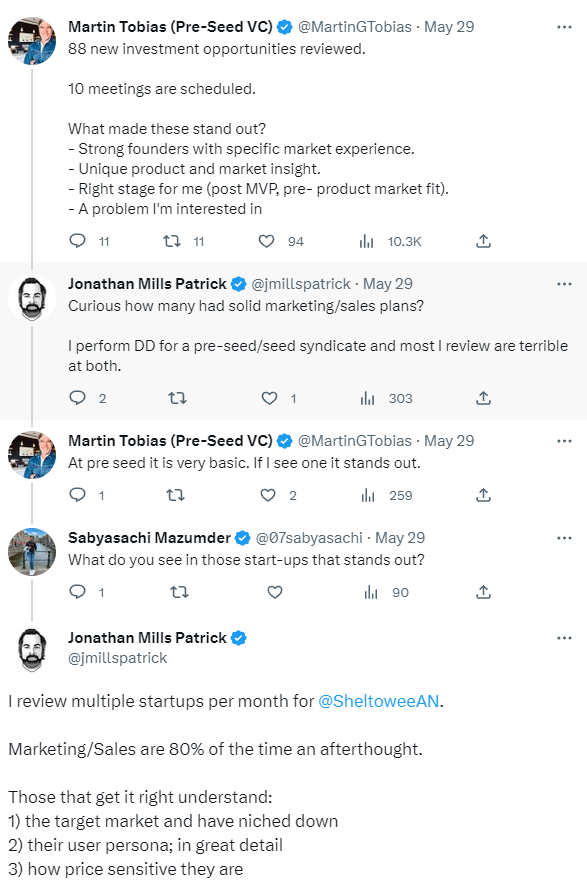I am involved as an investor and an analyst for a large angel investing syndicate, the Sheltowee Angel Network. As part of SANE, I perform monthly due diligence on potential investments for the network. The most common area that most of the startups I review fail at is their go-to-market activities.
I even shared as much on Twitter recently.

What causes this is a lack of a strong product development lifecycle (PDLC) that leaves out what I call the bookends of product management.
A normal PDLC
A normal product development lifecycle (PDLC) will look something like the following. Depending on your company’s PDLC, the order and activities in each phase can vary.
- Ideation: This is the stage where new product ideas are generated. This can be done through various means, such as market research, customer feedback, or brainstorming sessions.
- Validation: Once you have an idea, it needs to be validated. This involves defining the product's potential features, benefits, target market, user persona(s), pricing, and, most importantly, demand for the product. This step at my company also involves writing the business case to get funding approval for new product builds or enhancements that will cost beyond a certain dollar threshold.
- Product Design involves creating detailed product specifications, design drawings, and prototypes.
- Development: Now, it’s time to build the product. Your engineering team should be provided with the artifacts the team has created (e.g., a Product Requirements Document or PRD).
- Testing: In this stage, the product is tested and validated to ensure that it meets the required standards and specifications. This includes testing for functionality, usability, and reliability.
- Launch: Once the product has been tested and validated, it is ready for launch. This involves creating a marketing plan, identifying distribution channels, and launching the product.
- Post-Launch: After launching the product, we monitor and evaluate metrics to ensure it meets its sales targets and customer needs. This involves collecting and analyzing data on customer feedback, sales performance, and product defects.
Introducing the Bookends of Product Management
Looking at the above seven pieces of a PDLC, all put two of them are what I would consider go-to-market activities. Items #3, #4, and #5 are the exceptions. Items #1, #2, #6, and #7 encompass what I call the “Bookends of Product Management.”

Why bookends? Because without doing those GTM activities properly, your product will never stay standing in the market. In fact, I would argue that steps #2 (Validation) and #6 (Launch) are two of the most important steps in the PDLC. They are definitely where the startups I review for SANE miss the boat the most.
How My Team is Built to Excel at the Bookends
At my company, go-to-market activities have traditionally been the responsibility of the Technical Product Managers (TPMs) while being supported by Marketing. This created a scenario where the TPMs were spread thin.
As we built out my team’s structure, we deliberately split product manager responsibilities between technical and go-to-market functions. The TPMs focus on steps #3-#5, or the middle of the PDLC, and the GTM PMs focus on the bookends. This has allowed each group to be exceptional at what they do.
That’s not to say that the TPMs are excluded from GTM activities. Or vice versa. It is more a distinction of where they focus their energy.
We’ve seen some real benefits by allowing that focus, particularly in the bookends.
First and foremost is the amount of customer interaction we’ve been able to have. This has led to all kinds of discoveries that are impacting how we architect the product. A close second is the amount of internal communication we have been able to create. One of the things we learned early on is that there was a lot of confusion about what we were building. The GTM team has been able to spend significant cycles working to clear things up so that everyone in the company is on the same page, particularly when they are talking to customers.
Leveraging the Bookends at Your Company
Whether you work at a startup or are part of an established company, you can leverage this concept of bookends to build better products. To do that, I recommend the following steps.
- Review your PDLC and ensure it is aligned to create distinct GTM activities.
- Review your team structure. Are your PMs “jacks of all trades,” or are they focused on distinct phases of the PDLC?
- If you have TPMs leading GTM activities, find a way to establish a GTM PM role. I don’t see this as a 1:1 structure where one GTM PM supports one TPM. I also don’t see it as a 1:10 structure either. Depending on the products you are building and if they can be grouped, I anticipate the optimal GTM PM to TPM ratio to be closer to 3-5 to 1.
Since this approach is new at my company, I’ve yet to be able to vet that ratio. I’d love to hear your thoughts.
Enjoy this post?
Please consider sharing it with other people who might be interested in this type of content.
Or, if you have suggestions for topics you'd like me to cover, just hit reply and send me your suggestions.
